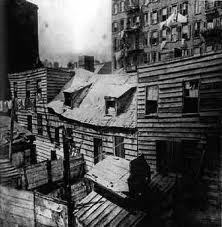Free Market Solutions: In 1890, Jacob Riis, one the world's first 'photo-journalists', published How The Other Half Lives, depicting the lives of New York's slum-dwellers. This is what affordable housing for the poor looks like when the provision of this vital social need is left to the tender mercies of "the free market".
WHAT IS IT ABOUT the National Party and state housing? What
is it about supplying safe, warm and affordable housing for the poorest New
Zealanders that they do not understand? Are Bill English and Paula Bennett so wedded
to the notion that ‘the market must decide’ that they are willing to live with
the squalor it inevitably engenders?
All around us we see the consequences of allowing market
forces to set New Zealand’s housing policy. Young, well-qualified Kiwis,
holding down good jobs on good pay, cannot afford to buy a house. While young
families, struggling to survive of a benefit, cannot even find one. Property
developers and builders, responding to market signals, construct dwellings for
those in search of large and expensive dwellings. The smaller, cheaper homes
New Zealand so desperately needs exist only in the dreams of the homeless, and
on the drawing-boards of progressive architects.
And what is the National Government’s response? To sell up
to a third of the state houses entrusted to it by the wisdom and compassion of
earlier generations of New Zealanders! When thousands of their fellow citizens
are living in damp, over-crowded houses; or caravan parks; or their cars; Mr
English and Ms Bennett are proposing to reduce the State’s stock of housing for
the poor. Why in God’s name would they want to do that?
National’s comeback is that the provision of social housing
is best left to religious, charitable, and other not-for-profit institutions.
The State, they say, is a poor landlord. The country’s poorer citizens, they insist,
will be better off in the care of the Salvation Army; or their local Iwi; or a
city council.
Really?
From what possible source will the not-for-profit sector
acquire the resources to construct social housing on a scale even remotely
commensurate to the urgent need of the homeless? What bank is going to lend
money to an institution whose prospective clients are required to endure the
most precarious of living conditions? There are very good reasons why very poor
people are refused mortgages. (As the whole world discovered in 2008, when the
US and UK banks’ insane decision to lend money to people who couldn’t possibly
pay it back triggered a global financial crisis.)
Nor is there the slightest historical justification for
believing that the housing needs of the poor can in any way be satisfied by the
charitable impulses of churches, individual philanthropists, or even – heresy
of heresies! – by the good offices of the free market’s mysterious “invisible
hand”.
We have all, at some time, used the expression “how the
other half lives”. But how many of us realise that it has its origin in a
scandal arising out of market-driven housing “solutions”? It was in 1890 that
one of the world’s first “photo-journalists”, Jacob Riis, published How the Other Half Lives: Studies among the
Tenements of New York, a collection of photographs depicting the horrendous
living conditions of the city’s slum-dwellers. The free-market’s “solution” to New
York’s ever-increasing demand for affordable housing was to construct gimcrack,
windowless, disease-ridden, fire-traps where whole families were forced to eke
out their sorry existence in a single, fetid room. To their credit, New York’s
middle-classes were shocked into action. Their radical reforms owed little to
market forces.
State Provided Solutions: A street of "State Houses" in New Zealand.
And neither did the radical reforms of the First Labour
Government. Because, fundamentally, market failure was the problem. Daringly,
Labour’s reformers borrowed the capital required to house the homeless
casualties of the Great Depression from “NZ Inc”, in the form of Reserve Bank
credit. We paid ourselves back out of the increased revenue generated by the
housing programme itself (state houses were built, as a far as possible, out of
local materials) and, over time, out of the rentals of the tenants themselves.
(Being immortal entities, states can wait a long time for their loans to be
repaid!)
Has the Government truly forgotten that there is NO non-squalid
market-driven solution to a market-induced crisis in affordable housing? Mr
English and Ms Bennett certainly haven’t forgotten. If you press them they will
admit that their own government may end up lending the potential purchasers of
state houses the money needed to acquire our long-ago amortised assets. Yes,
that’s right, National’s “market-driven” solution to the housing crisis is to
require taxpayers to heavily subsidise private investment in property they
already own because the new owners’ “independence” from the State better
qualifies them to manage the nation’s stock of social housing than the State
itself.
But even if that were true, the State’s alleged indifference
as a landlord is almost entirely attributable to the National Party’s
longstanding antipathy to the idea that when it comes to putting a roof over
people’s heads we are, and must remain, “our brothers’ keeper”. Ultimately, the Government’s market-driven
alternative can only be achieved by squander and squalor.
This essay was
originally published in The Press of Tuesday,
4 November 2014.


